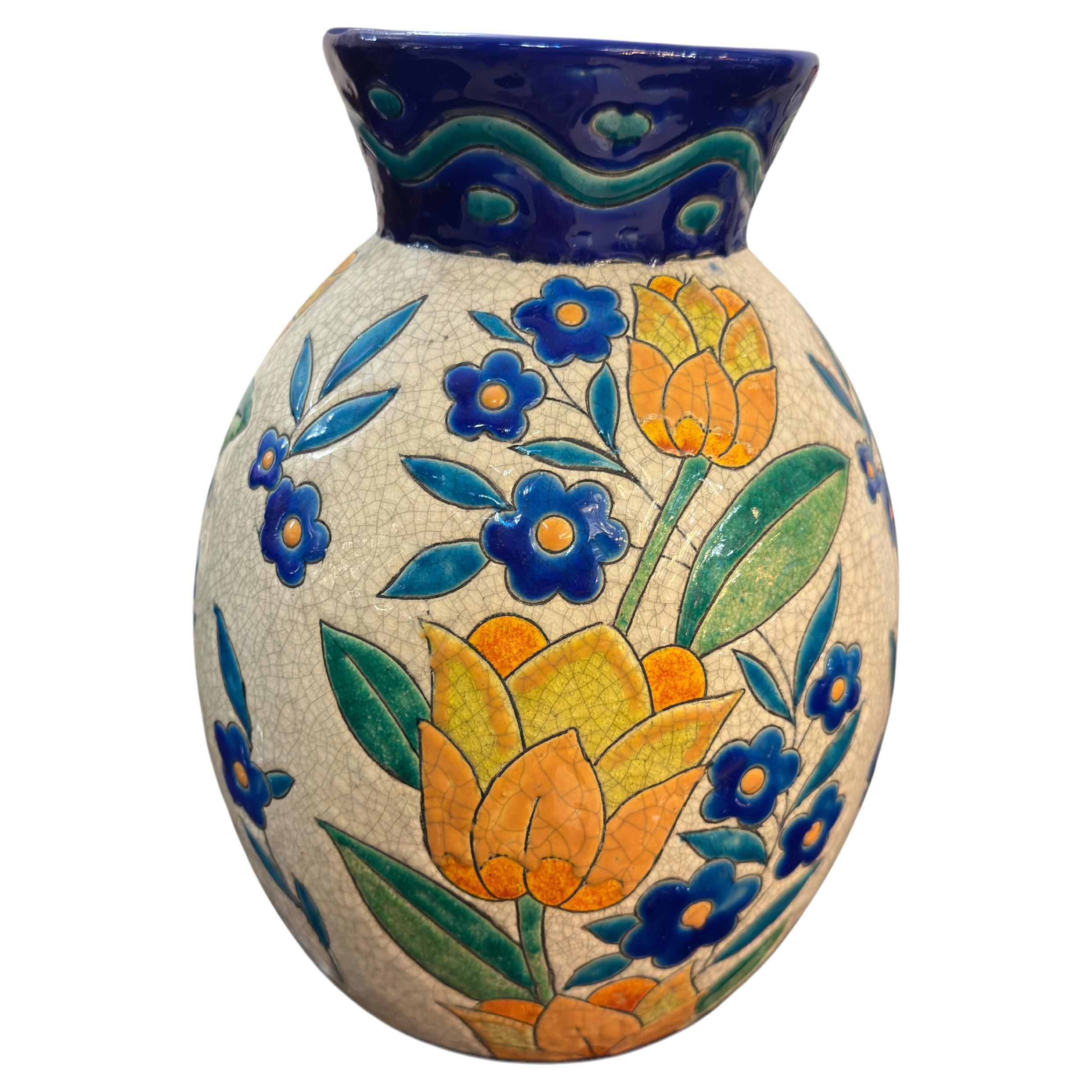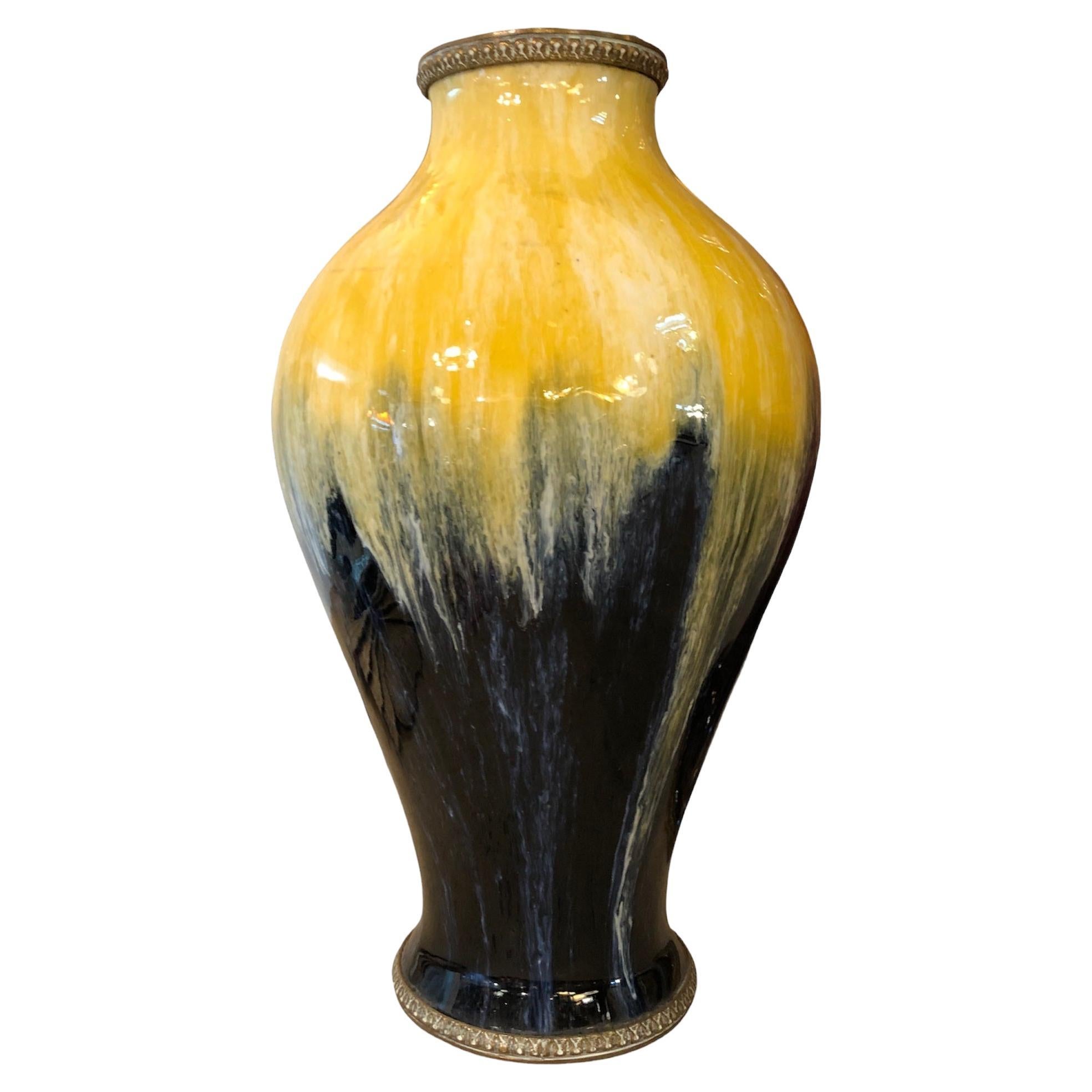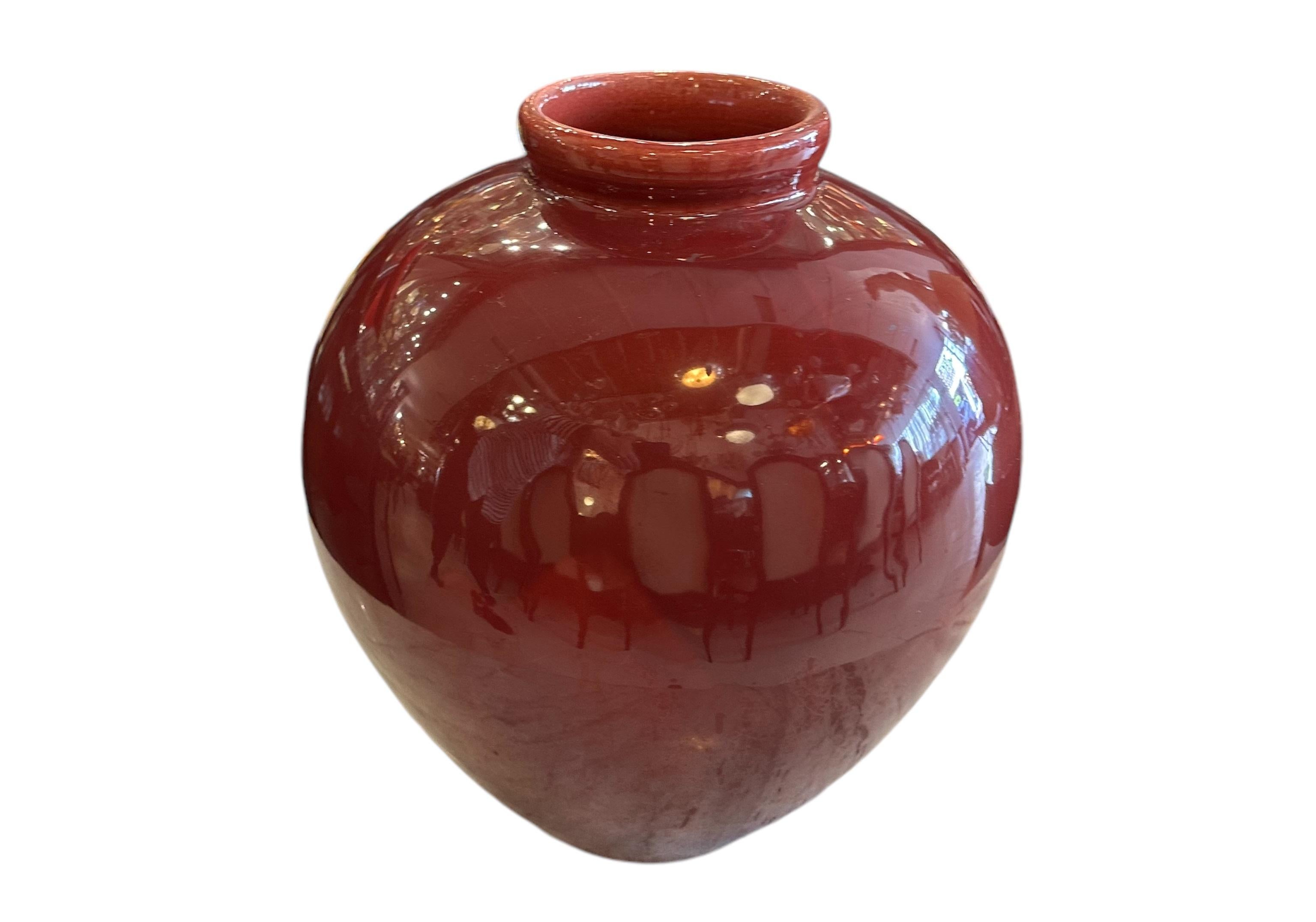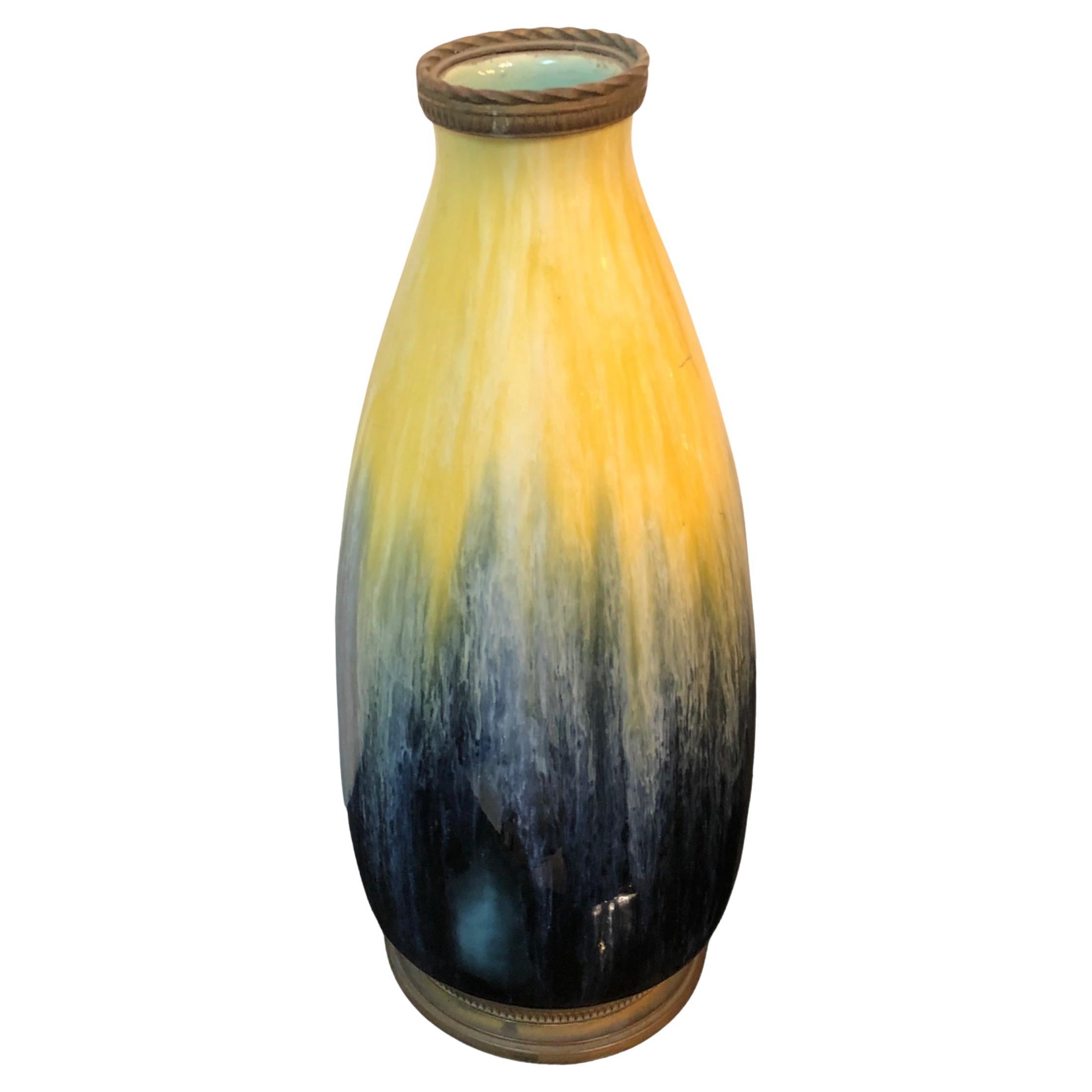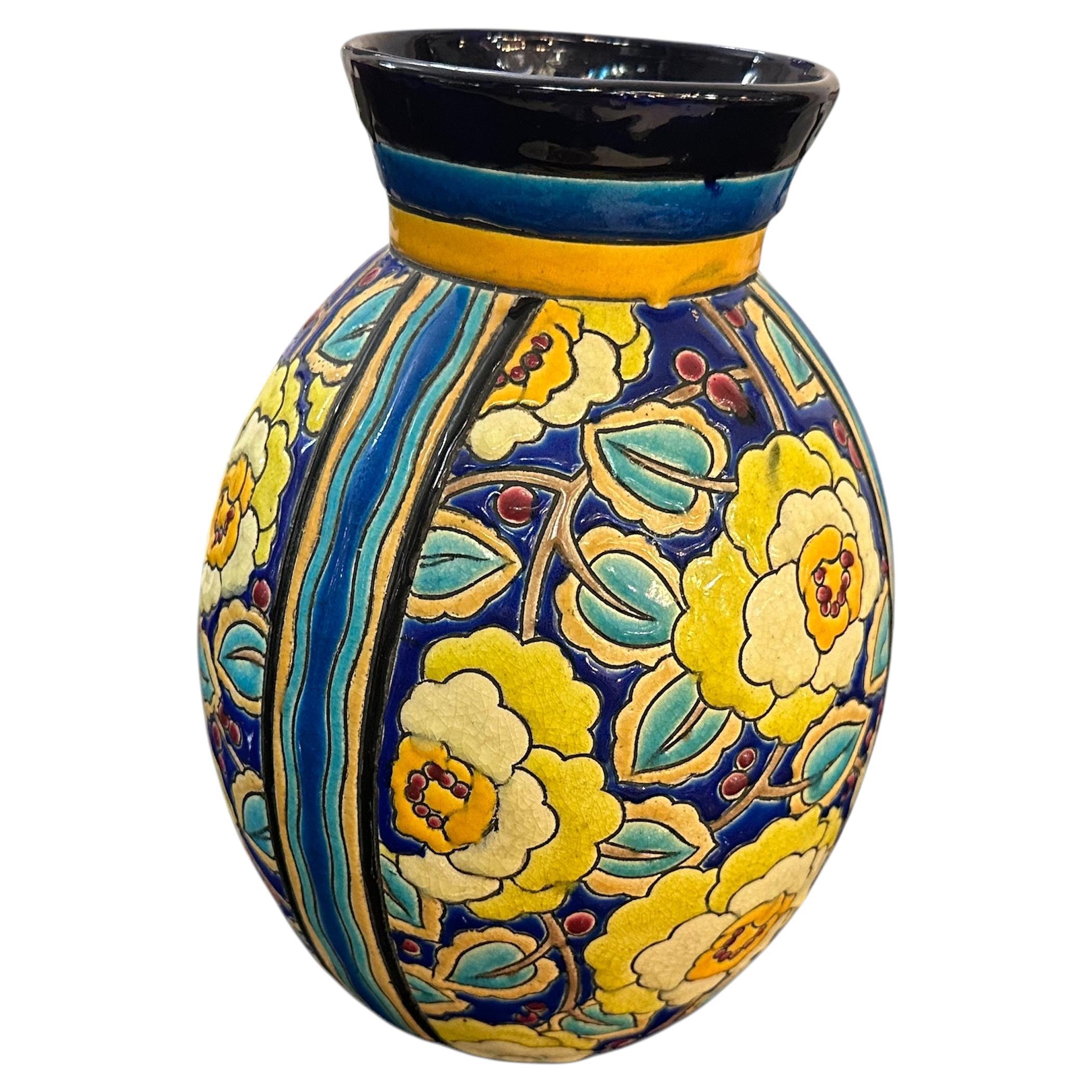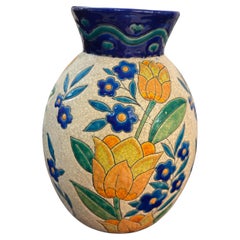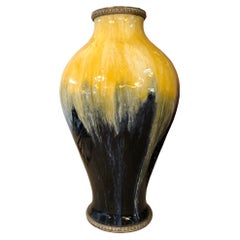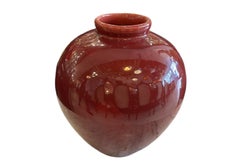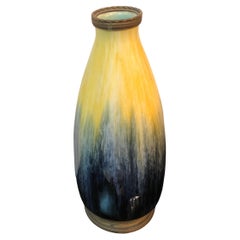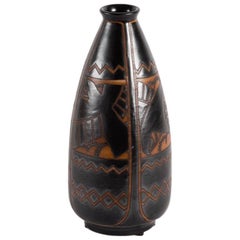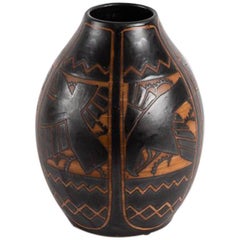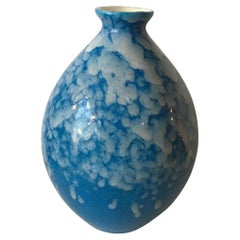Items Similar to Ceramic, Made in Belgium, Ch Catteau , Dr 289, LD
Video Loading
Want more images or videos?
Request additional images or videos from the seller
1 of 20
Ceramic, Made in Belgium, Ch Catteau , Dr 289, LD
About the Item
Franco-Belgian ceramist Charles Catteau could be regarded as one of the most versatile ceramic artists of his generation, especially for the style of Art Deco. Catteau advanced the forms, techniques and decoration of modern ceramics, creating an exceptionally original, new and decorative genre.
Hired as a ceramic decorator in Ecole Nationale de Sèvres from 1903 to 1904, he began producing designs that were rather traditional, based on the observation of nature, and showing the influence of Japonism, characterised by pure lines and meticulous details. From 1904 to 1906, he worked in Nymphemburg Porzellan Manufaktur near Munich, a factory specialising in new hand painting procedures under a slip, as well as Art Nouveau.
In 1907 he finally moved to Louvière in Belgium where he was promoted to head of the decoration department at Boch Freres Keramis at the age of 27. This is where most of his exceptional talent came to the fore especially during the period between the two World Wars. Influenced by the great creative art movements of the time (Africanism, Japonism, Cubism, Abstraction) and his observation of nature gave him inspiration for his designs, with the integration of plants, stylized animals and geometric motifs. The international avant-garde movements were also an influence leading to his use of purely abstract, geometric designs and intense colours. Charles Catteau was incredibly resourceful and explored various harmonies of form, techniques, designs, colours, shades, topics, variants and influences. In this way Catteau became a representative par excellence of Art Deco designs, giving it his personal touch. He was instrumental in introducing technical innovations during the 20’s and 30’s to aid mass production of ceramic products and expand availabiltity of affordable products. During difficult times in Europe, he created vivid, colourful, orignal and uplifting ceramic wares.
Charles Cotteau motto was “Art for All” and he also taught decorative painting at the School of Industrial in Louvière. In 1925 he obtained international recognition in the exhibition of Decorative Arts in Paris. which helped raise the profile of Boch Freres. He remained at the company until he retired to Nice in 1946 .
The renaissance of his artistic legacy is largely due to the popularity of the many collectible aspects of his creations.
We have specialized in the sale of Art Deco and Art Nouveau and Vintage styles since 1982. If you have any questions we are at your disposal.
Pushing the button that reads 'View All From Seller'. And you can see more objects to the style for sale.
Why are there so many antiques in Argentina?
In the 1880 – 1940 there was a grate wave of immigration encouraged by the periods of war that were taking place.
1st World War took place between 1914 and 1918
2nd World War took place between 1939 and 1945
The immigrants options were New York or Buenos Aires. Tickets were cheap and in Buenos Aires they were welcomed with open arms, as it was a country where everything was still to be done.
Argentina was the country of new opportunities, labour was needed and religious freedom was assured, in many cases the of the family travel first until they were settled and then the rest of the family members join them.
In the immigrant museum “Ellis Island Immigrant Building” in New York you can se the promotional posters of the boats that would take them to a new life.
Between the years 1895 and 1896, Argentina had the highest DGP (gross domestic product) per capita in the world according to the Maddison Historical Statistics index, this situation arose due to the large amount of food being exported to European countries, which were at war.
The Argentinean ships left the port of Buenos Aires with food, but they returned with furniture, clothes and construction elements, (it´s common to see this the old buildings of the historic neighbourhood of San Telmo, the beams with the inscription “Made in England)”, as well as many markets that were built in Buenos Aires, such us the San Telmo Market, whose structure was brought by ship and afterwards assembled in 900 Defensa Street.
With the great influence of European immigrants living in the country, the children of the upper classes travelled to study in France, resulting in the inauguration of “La Maison Argentinienne”, on 27th of June 1928, in the international city of Paris, which hosted many Argentinians that were studying in Frace.
It´s the fourth house to be built after France, Canada and Belgium, being the first Spanish-speaking one. Still in place today (17 Bd Jourdan, 75014, Paris, France). Many of the children of these wealthy families who attended international art exhibitions, museums and art courses abroad, took a keen interest in the European style. This is why Buenos Aires was at the time referred as “The Paris of South America”.
Between the years 1890 and 1920 more than a hundred Palaces were built on Alvear Avenue the most exclusive avenue in Buenos Aires. Today some of these palaces have been transformed into museums, hotels and embassies.
In the year 1936, the Kavanagh building was inaugurated, it was the tallest reinforced concrete building in South America.
During 1994 the American Society of Civil Engineers distinguished it as an “international engineering milestone”, and it´s now considered a World Heritage of Modern Architecture.
At the time was common to hire foreign architects such as Le Corbusier, who visited Buenos Aires/Argentina in 1929 and in 1948 he drew up the blueprints for a house built in La Plata City (which was declared a World Heritage Site).
In 1947, the Hungarian architect Marcelo Breuer designed “Parador Ariston” in the seaside city of Mar del Plata. After an Argentinean student at Harvard University convinced him to come to Argentina. He worked on an urban development project in the Casa Amarilla, area of La Boca.
The Ukrainian architect, Vladimiro Acosta, arrives in Argentina in 1928 and worked as an architect until que moved to Brazil.
Antonio Bonet, a Spanish architect who worked with Le Corbusier in Paris, arrives in Argentina in 1937, where he carried out several architectural works and in 1938 designs the well-known BFK chair.
Andres Kálnay, of Hungarian origin, made around 120 architectural masterpieces, among which the former Munich brewery stands out, he even made the furniture’s design.
The German architect, Walter Gropius, director of the Bauhaus, lived in Argentina, where he wrote articles for “Sur” magazine and founded in Buenos Aires, an architectural firm with Franz Möller, who was also an architect, where he built two houses.
At the same time several famous designers decided to immigrate to Argentina, among them we can find the well-known French designer, Jean-Michel Frank, who arrived in the country in 1940 and also worked for the Rockefeller family.
Special pieces were made, which were sold exclusively in the country, such as the well-known German company “WMF”, who sold their products by catalogue, which were chosen by the ladies of High Society in the list of wedding gifts, as well as the pieces designed by Christofle.
The Swiss sculptor Alberto Giacometti, made special pieces for Argentinean mansions.
In 1904 the first Jansen branch outside Paris was established in Buenos Aires, as the Argentinean clientele demanded a large amount of furniture, from the end of the 19th century to the mid-20th century.
In 1970, the brand Rigolleau Argentina made pieces authorised by Lalique.
The brands Maple and Thompson also set up shop in the country.
The French plastic artist, Marcel Duchamp moved to Argentina in 1918-1919.
Glass signed Gallé, Charder, Leverre, Schneider, Muller and other French firms. They were bought in flower shops and were given to ladies with beautiful floral arrangements.
Some furniture manufacturers travelled to international fairs and bough the patterns to produce the furniture in Argentina, such as the furniture firm Englander and Bonta, who bought the patterns ins Italy.
It is worth mentioning that in Argentina we have the largest Community of Italians outside of Italy, as it is estimated that 70 percent of the inhabitants have at least one Italian descendant, followed by Spanish immigrants.
The most Important furniture stores in Argentina:
Comte is founded in 1934 (under the direct management of Jean Michel Frank in 1940).
Nordiska (Swedish company established in 1934).
Churba in 1960, a company that brought foreign designers to present their furniture in the country:
Denmark: (Arne Jacobsen, Finn Juhl, Bender Madsen, Ejner Larsen, Poul Kjaerholm, Hans Wegner)
Sweden: (Hans Agne Jakobsson, Gustavsberg)
United States: (Herman Miller)
Finland: (Lisa Johansson, Folke Arstrom, Tapio Wirkkala, Alvar Aalto, Timo Sarpaneva)
Swedish Factory: (Orrefors)
Italy: (Littala, Vico Magistretti, Emma Gismondi, Gae Aulenti, Angelo Mangiarotti, Elio Martinelli, Gianna Celada, Angelo Mangiarotti, Mario Bellini, Carlo Scarpa)
Finland: (Olivia Toikka)
Plata Lappas (Lappas Silver): a goldsmith shop founded in 1887 in Argentina by Alcibiades Lappas of Greek origin.
In 2019, in Argentina took place “the Art Deco world congress”, in which we participated as hosts invited by Geo Darder, founder of the Copperbridge – Foundation, in which prominent people from all over the world attended to learn about Art Deco in Argentina.
Argentina currently has more than 100 Art Deco buildings and another 90 Art Nouveau buildings throughout the city of Buenos Aires.
Argentina is a country that has not been involved in many wars, which is why it has been a refuge for works of art and antiques from different periods of time, unlike European countries. That is way many collectors, museums and antique dealers from all over the world visit it, you should not miss the opportunity to visit this great country.
Laura Guevara Kjuder, architect.
- Creator:Charles Catteau (Author)
- Dimensions:Height: 12.6 in (32 cm)Diameter: 7.09 in (18 cm)
- Style:Art Deco (Of the Period)
- Materials and Techniques:
- Place of Origin:
- Period:
- Date of Manufacture:1930
- Condition:Wear consistent with age and use.
- Seller Location:Ciudad Autónoma Buenos Aires, AR
- Reference Number:Seller: C-1stDibs: LU6785244133602
About the Seller
5.0
Vetted Professional Seller
Every seller passes strict standards for authenticity and reliability
Established in 1982
1stDibs seller since 2022
35 sales on 1stDibs
Typical response time: <1 hour
- ShippingRetrieving quote...Shipping from: Ciudad Autónoma Buenos Aires, Argentina
- Return Policy
Authenticity Guarantee
In the unlikely event there’s an issue with an item’s authenticity, contact us within 1 year for a full refund. DetailsMoney-Back Guarantee
If your item is not as described, is damaged in transit, or does not arrive, contact us within 7 days for a full refund. Details24-Hour Cancellation
You have a 24-hour grace period in which to reconsider your purchase, with no questions asked.Vetted Professional Sellers
Our world-class sellers must adhere to strict standards for service and quality, maintaining the integrity of our listings.Price-Match Guarantee
If you find that a seller listed the same item for a lower price elsewhere, we’ll match it.Trusted Global Delivery
Our best-in-class carrier network provides specialized shipping options worldwide, including custom delivery.More From This Seller
View AllCeramic, Made in Belgium
Located in Ciudad Autónoma Buenos Aires, C
Ceramic: Sign: Made in Belgium, Boch F. La louviere Fabrication Belge
The Boch manufacture was established in Belgian La Louvière by Jean-François Boch, one of main owners of another...
Category
Vintage 1920s Belgian Art Deco Centerpieces
Materials
Ceramic
$10,500
Ceramic Sign: Made in Belgium, Boch F. La louviere Fabrication Belge
By Boch La Louviere
Located in Ciudad Autónoma Buenos Aires, C
Ceramic: Sign: Made in Belgium, Boch F. La louviere Fabrication Belge
The Boch manufacture was established in Belgian La Louvière by Jean-François Boch, one of main owners of another...
Category
Vintage 1920s Belgian Art Deco Centerpieces
Materials
Bronze
Ceramic Sign: Made in Belgium, Boch F. La louviere Fabrication Belge
By Boch La Louviere
Located in Ciudad Autónoma Buenos Aires, C
Ceramic: Sign: Made in Belgium, Boch F. La louviere Fabrication Belge
The Boch manufacture was established in Belgian La Louvière by Jean-François Boch, one of main owners of another...
Category
Vintage 1920s Belgian Art Deco Centerpieces
Materials
Ceramic
Ceramic Sign: Boch F. La louviere Fabrication Belge, Made in Belgium 898
By Boch La Louviere
Located in Ciudad Autónoma Buenos Aires, C
Sign: Boch F. La louviere Fabrication Belge, Made in Belgium 898
The Boch manufacture was established in Belgian La Louvière by Jean-François Boch, one of main owners of another know...
Category
Vintage 1920s Belgian Art Deco Centerpieces
Materials
Bronze
Ceramic Sign: Made in Belgium, Boch F. La louviere Fabrication Belge D.2813
By Boch La Louviere
Located in Ciudad Autónoma Buenos Aires, C
Ceramic: Sign: Made in Belgium, Boch F. La louviere Fabrication Belge
The Boch manufacture was established in Belgian La Louvière by Jean-François Boch, one of main owners of another...
Category
Vintage 1920s Belgian Art Deco Centerpieces
Materials
Ceramic
Ceramic Sign: Made in Belgium, Boch F. La louviere Fabrication Belge 976
By Boch La Louviere
Located in Ciudad Autónoma Buenos Aires, C
Ceramic: Sign: Made in Belgium, Boch F. La louviere Fabrication Belge
The Boch manufacture was established in Belgian La Louvière by Jean-François Boch, one of main owners of another...
Category
Vintage 1920s Belgian Art Deco Centerpieces
Materials
Ceramic
You May Also Like
Charles Catteau for Kéramis, Art Deco Ceramic Vase, Belgium, 1925
By Boch Freres Keramis, Charles Catteau
Located in New York, NY
Signed in ink: Ch. Catteau
Marked in ink: D.1009 (design number)
Incised: Grès Kéramis and 898 (shape number)
Stamped: Boch F es La Louvière made in Belgium
This vase displays Catte...
Category
Early 20th Century Belgian Art Deco Vases
Materials
Stoneware
Charles Catteau for Kéramis, Art Deco Vase, Belgium, 1925
By Boch La Louviere, Charles Catteau
Located in New York, NY
Signed in ink: Ch. Catteau
Marked in ink: D.1009 (design number)
Incised: Grès Kéramis and 901 (shape number)
Stamped: Boch F es La Louvière made in Belgi...
Category
Early 20th Century Belgian Art Deco Vases
Materials
Stoneware
Ceramic vase by Charles Catteau Edition Boch 1930
By Charles Catteau, Boch Freres Keramis
Located in LE CANNET, FR
Glazed ceramic vase. Very beautiful blue polychrome enamelling, decorated with white spots. Published in the 1930s by Boch
Charles Catteau (1980-1966) trained as a ceramic engineer ...
Category
Vintage 1930s Belgian Art Deco Ceramics
Materials
Ceramic
Charles catteau ceramics Boch
By Charles Catteau
Located in Buenos Aires, Argentina
Art Deco glass ceramic manufactured Boch
Design Charles Catteau
French Belgian origin
perfect condition.
Category
Vintage 1920s French Art Deco Ceramics
Materials
Ceramic
Rare Large Art Deco Centerpiece by Winterhalder Made in Cupertino, CA, 1947
By Erwin Winterhalder
Located in Philadelphia, PA
Brilliantly glazed in chartreuse-yellow and Mediterranean blue-green, this unique and important Art Deco bowl was made by Erwin Winterhalder in Cupertino. The artist was born in Swit...
Category
Vintage 1940s American Art Deco Centerpieces
Materials
Ceramic
Vintage Chinese Tray in Ceramic Hand Painted
Located in Milano, IT
Beautiful vintage Chinese ceramic tray dating from the early 1900s, also useful as a pocket emptier or centerpiece.
The vintage Chinese tray is entirely ha...
Category
20th Century Chinese Chinese Export Ceramics
Materials
Ceramic
$1,671 Sale Price / set
20% Off
Recently Viewed
View AllMore Ways To Browse
Travel Poster 1920s
1939 New York Worlds Fair Finnish
1939 Worlds Fair Poster
Vintage Wedding Designers
Swiss 30 Made
1890 Plant Stand
1920s Plant Stand
19th Century European Still Life Paintings
American Art Deco Antique Painting
Wedding Head Pieces
1920s Slipers
Wedding Slip
Vintage Charles Jourdan
Hand With Raised Index
19th Century Spanish Renaissance Dining Furniture
Louis Seize Bureau
Louis Vuitton Bugatti
Louis Vuitton Sailing Poster
